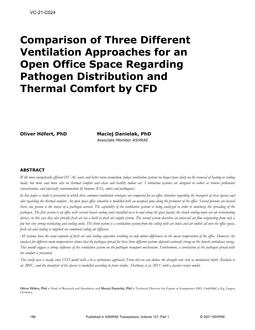
VC-21-C024 — Comparison of Three Different Ventilation Approaches for an Open Office Space Regarding Pathogen Distribution and Thermal Comfort by CFD
- Comments Off on VC-21-C024 — Comparison of Three Different Ventilation Approaches for an Open Office Space Regarding Pathogen Distribution and Thermal Comfort by CFD
- ASHRAE
With more energetically efficient HVAC units and better room insulation, todays ventilation systems no longer focus solely on the removal of heating or cooling loads, but more and more also on thermal comfort and clean and healthy indoor air. Ventilation systems are designed to reduce or remove pollutants concentration, and especially contamination by humans (CO2, odors and pathogens).
In this paper a study is presented in which three common ventilation strategies are compared for an office situation regarding the transport of these species and also regarding the thermal comfort. An open space office situation is modelled with an occupied zone along the perimeter of the office. Several persons are located there, one person is the source of a pathogen aerosol. The capability of the ventilation systems is being analyzed in order to minimize the spreading of the pathogen. The first system is an office with several trench cooling units installed next to and along the glass façade, the trench cooling units are air recirculating devices, in this case they also provide fresh air via a built-in fresh air supply system. The second system describes an uniaxial air flow originating from only a few but very strong ventilating and cooling units. The third system is a ventilation system from the ceiling with air inlets and air outlets all over the office space, fresh air and cooling is supplied via combined ceiling air diffusers.
All systems have the same amount of fresh air and cooling capacities resulting in only minor differences in the mean temperature of the office. However, the analysis for different room temperatures shows that the pathogen spread for these three different systems depends variously strong on the kinetic turbulence energy. This would suggest a strong influence of the ventilation system on the pathogen transport mechanism. Furthermore, a correlation of the pathogen spread with the comfort is presented.
This study uses a steady state CFD model with a k-ω turbulence approach. From this we can deduce the draught rate risk as mentioned before [Koskela et al, 2001], and the transport of the species is modelled according to prior studies [Hathway et al, 2011] with a passive scalar model.
Citation: 2021 Virtual Conference Papers
Product Details
- Published:
- 2021
- Units of Measure:
- Dual
- File Size:
- 1 file , 1.1 MB
- Product Code(s):
- D-VC-21-C024

